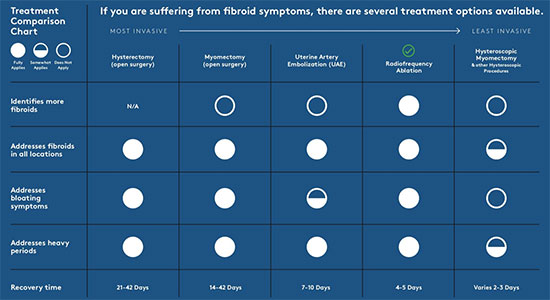Radio Frequency Ablation
 The Women’s Medical Center of Brookwood Baptist Health offers radio frequency ablation to eliminates uterine fibroids. If you suffer from heavy or prolonged
menstrual bleeding, abdominal pain and pressure, frequent urination and low energy due to anemia, you may have uterine fibroids. Uterine fibroids are very common. In fact, approximately 70% of women have fibroids by age 50. If you suffer from these
symptoms and have been diagnosed with uterine fibroids, you may be a candidate for our procedure.
The Women’s Medical Center of Brookwood Baptist Health offers radio frequency ablation to eliminates uterine fibroids. If you suffer from heavy or prolonged
menstrual bleeding, abdominal pain and pressure, frequent urination and low energy due to anemia, you may have uterine fibroids. Uterine fibroids are very common. In fact, approximately 70% of women have fibroids by age 50. If you suffer from these
symptoms and have been diagnosed with uterine fibroids, you may be a candidate for our procedure.
What are Uterine Fibroids?
Uterine fibroids are benign tumors that grow in or on the uterus. They are surprisingly common, occurring in 80 percent of women by the age of 50.
Treatments
What Treatments Are Available?
Non-surgical treatments
- Watchful Waiting
Fibroids are benign, slow growing tumors that rarely interfere with pregnancy, therefore if the patient is not experiencing any complications from the fibroids, a watch and wait approach might be recommended first. - Medication
While medications cannot eliminate fibroids, they can shrink them and address some of the symptoms such as heavy periods and pelvic pressure. Medications include: - Gonadotropin-releasing hormone (GnRH) agonists
Estrogen and progesterone are blocked, putting the body in a menopause-like state which may lighten heavy periods and may cause fibroids to shrink. - Intrauterine Devices (IUDs)
IUDs that release progestin may provide relief from heavy bleeding caused by fibroids, but do not shrink fibroids. - Tranexamic acid
Tranexamic acid is a non-hormonal medication that may ease heavy bleeding caused by fibroids. - Other birth control
Oral contraceptives may offer relief for menstrual bleeding, but these medications do not shrink fibroids. - MRI-guided focused ultrasound surgery (FUS)
Focused ultrasound surgery is a noninvasive treatment option that is performed while the patient is inside an MRI scanner. The imaging equipment provides the doctor with a clear picture of the location of the fibroids which are then targeted with ultrasound waves that apply heat to destroy smaller fibroids.
Surgical treatments
Several treatment options available to treat fibroids, including:
Procedure Steps:
- Hysterectomy (open surgery)
- Myomectomy (open surgery)
- Uterine Artery Embolization (UAE)
- Radiofrequency Ablation (RFA)
- Hysteroscopic Myomectomy
The RFA Procedure
What is the RFA Procedure?
Radiofrequency Ablation (RFA) is a minimally invasive treatment that does not surgically remove uterine fibroids, but shrinks them over time.
Results & Benefits
What are the Results & Benefits?
- Relief – After treatment the fibroid continues to shrink over time, other symptoms like heavy, long periods and looking pregnant when you’re not, can take 3+ months to improve.
- Scientifically Proven – Many patients see the most relief within 3 months, and continuing improvement out to 12 months and beyond.
- Uterine sparing – only treats the fibroids.
- Minimally invasive – 3 small incisions, no suturing of uterine tissue.
- Quick recovery– return to work in 4-5 days.
- Clinical evidence – proven on highly symptomatic patients.
- Treats nearly all types of fibroids – fewer small fibroids left behind.
- Addresses symptoms – including heavy bleeding and bulk.
- Lower intraoperative blood loss – compared to myomectomy and hysterectomy.
